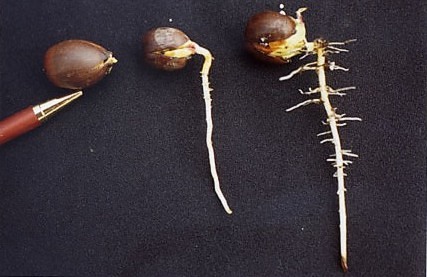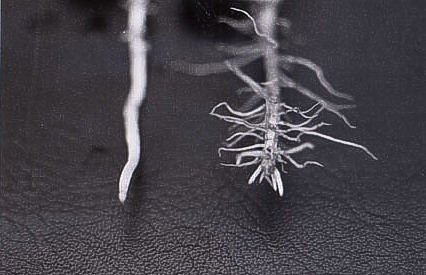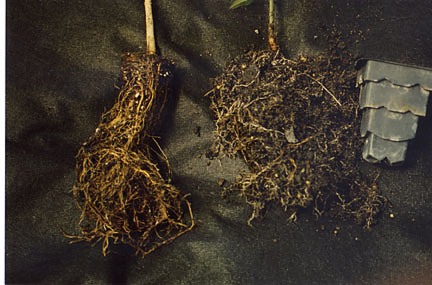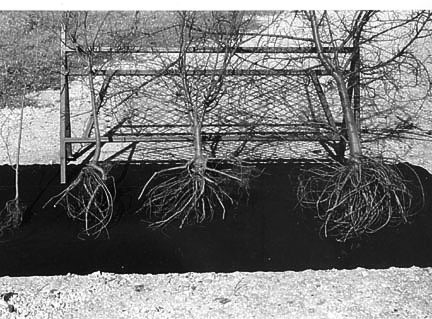Doing it Right
The Sure-fire Way to Raise Trees
 |
The shumard oak, Quercus shumardii, seed at left is in the earliest detectable stage of germination. The seed at the center is three days older than this. The seedling at the right has experienced air-root-pruning at a depth of four inches (note the dead, darkened tip), and has begun to produce secondary horizontal roots. The primary shoot is beginning to emerge - and all this in just four days. |
|
After seven days a shumard oak seedling allowed to grow with air-root-pruning had reached a depth of nine inches and showed essentially no more secondary roots than the three-day old seedling shown in the first picture. By contrast the tip of the taproot that had been air-root-pruned at a depth of four inches had produced horizontal roots above the point of pruning that were not evident in the four-day old seedling above. |
 |
In addition four branch roots had formed just behind the point of pruning of the taproot. These are larger in diameter than the horizontal roots and would reestablish a multiple taproot if left unchecked. It is only after a secondary and perhaps tertiary air-root-pruning of roots which attempt to form a taproot that the desirable horizontal secondary roots along the short vertical main axis will begin more rapid growth.
|
Following transplanting, roots extend in the direction in which they were oriented in the previous container. The shumard oak seedlings in these pictures were transplanted from the plug and RootMaker® container shown above into three-gallon containers. They were then removed after three weeks to observe root development. The seedlings that came from the plug container had all their roots growing downwards. The seedlings from the RootMaker® with air-root-pruning on the sides as well as the bottom, had roots extending in all directions. |
 |
The Proof of the Pudding
 |
The lacebark elm (Ulmus parvifolia) seedling at the right was grown under conditions that stimulated optimum horizontal root development. The three seedlings to the left were grown under conditions less and less favorable to the stimulation of horizontal root growth |
| The most striking part of this comparison is that after the treatment in the early seedling stage, all four trees (which are of the same age) were grown for two years under identical conditions in the field. | |
Dr. Carl Whitcomb is the president of Lacebark Inc.,Publications and Research, of Stillwater, OK. He is always willing to discuss his research results and their application to tree raising. Tel. 405 377 3539
Back to the Table of Contents